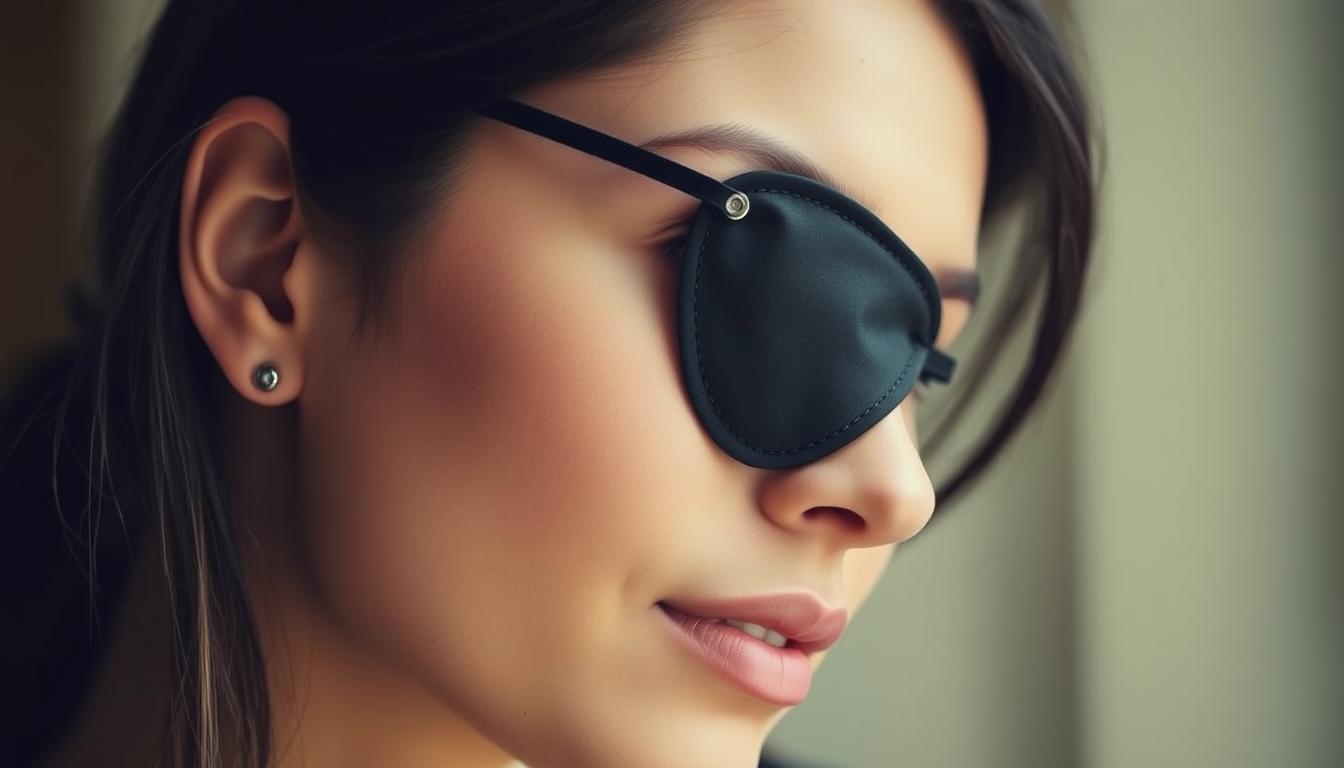Recovering from surgery is tough, and knowing how long to wear compression socks is key. The time you need to wear them after surgery depends on the surgery type and your health.
Compression socks are vital for your recovery. They help stop blood clots, reduce swelling, and keep blood flowing right. If you’re getting ready for surgery or recovering, knowing how long to wear them is important. It can really help your healing.
Doctors often say wearing compression socks is a must after surgery. They give your body the support it needs to heal better. This can help avoid problems and speed up your recovery.
Key Takeaways
- Compression socks are critical for post-surgical recovery
- Duration of wear varies by surgical procedure
- Helps prevent blood clots and reduce swelling
- Consult your healthcare provider for personalized guidance
- Proper fit is essential for maximum effectiveness
Understanding the Importance of Compression Socks in Post-Surgical Recovery
After surgery, your body needs extra care to heal right. Wearing compression socks is key to your recovery. These socks are more than just clothes; they help your body heal.
Our bodies face a lot of stress during surgery. That’s why post-surgery care is so important. Compression socks help by improving blood flow and preventing complications.
Benefits of Compression Therapy After Operations
- Reduces swelling in surgical areas
- Improves blood circulation
- Minimizes risk of blood clots
- Supports faster healing process
How Compression Socks Support Healing
Compression socks apply gentle pressure to your legs. This helps:
- Prevent blood pooling in lower extremities
- Reduce inflammation
- Speed up oxygen and nutrient delivery to healing tissues
Prevention of Post-Surgical Complications
| Complication | Compression Sock Prevention Strategy |
|---|---|
| Deep Vein Thrombosis | Maintains consistent blood flow |
| Leg Swelling | Reduces fluid accumulation |
| Muscle Stiffness | Supports muscle recovery |
Pro tip: Always check with your healthcare provider about the right compression socks for your recovery.
Types of Surgeries That Require Compression Socks
Not all surgeries need the same amount of time with compression socks. Knowing how long you should wear them can help your recovery. Each surgery has its own needs for how long to wear compression socks.
Many surgeries need compression socks to help with healing and avoid problems:
- Orthopedic Surgeries
- Knee replacements
- Hip surgeries
- Ankle reconstruction
- Vascular Procedures
- Varicose vein treatments
- Venous bypass surgeries
- Arterial interventions
- Major Abdominal Surgeries
- Hernia repairs
- Colorectal operations
- Bariatric procedures
People having these surgeries often need to follow special rules for wearing compression socks. How long you should wear them depends on your health, the surgery’s complexity, and the risk of blood clots.
Talking to your doctor is key to figuring out the right time to wear compression socks for your situation.
General Guidelines for Post-Surgery Compression Sock Usage
Using compression socks after surgery can seem daunting. We’ve put together a detailed guide. It helps you understand how long to wear them and how to do it right.
Recovery is a journey, and your compression socks are there to help. They play a big role in your healing and preventing problems.
Day and Night Wear Requirements
Knowing when to wear compression socks is important for recovery. Here’s what our experts suggest:
- Wear socks during the day
- Keep them on at night too
- Follow your doctor’s advice on how long to wear them
Proper Fitting and Application
Finding the right fit is key for benefits. Compression socks should be snug but not too tight. Here are some tips for putting them on:
- Smooth out wrinkles when putting them on
- Make sure the compression is even from ankle to thigh
- Check if they’re comfortable and properly aligned
Signs of Correct Compression Level
How do you know your socks are working right? Look for these signs:
- Less swelling in your legs and feet
- Little to no discomfort
- No issues with blood flow
- Support all day long
Always talk to your doctor for advice on wearing compression socks during your recovery.
How Long Do You Wear Compression Socks After Surgery
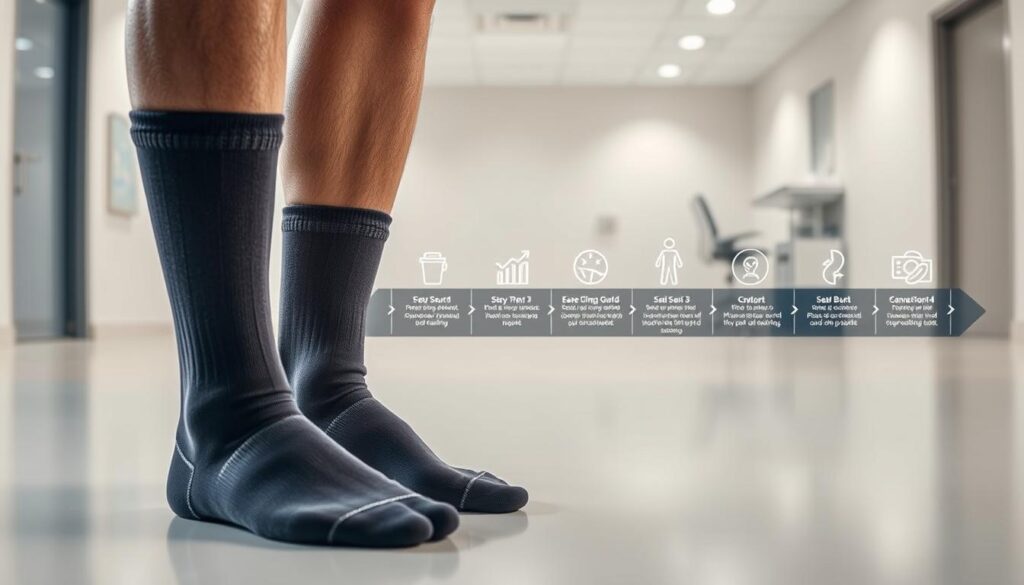
Knowing how long to wear compression socks after surgery is key for a good recovery. The time needed varies based on several important factors. It’s vital to follow the advice given by your doctor.
Many patients ask how long they should wear compression socks after surgery. Doctors usually suggest wearing them for a certain time. This time can be:
- 1-2 weeks for minor surgeries
- 4-6 weeks for bigger surgeries
- Up to 8 weeks for major orthopedic surgeries
The right time to wear compression socks depends on a few things:
- Type of surgery
- How fast you heal
- Your overall health
- Risk of blood clots
- How mobile you are during recovery
It’s important to talk to your doctor about how long to wear compression socks. Some people might need them for less time, while others might need them longer. This helps with healing and prevents problems.
Watching how you recover and listening to your doctor is essential. Every person’s recovery is different. Getting advice tailored to you helps you heal the best way possible.
Different Recovery Phases and Compression Requirements
Recovering from surgery is a journey with different stages. Each stage needs a specific way to use compression socks. The time you wear compression socks after surgery depends on how you heal and the surgery type.
Let’s look at the recovery period with compression socks in three key phases:
Immediate Post-Surgery Period
The first phase is key to stop blood clots and help healing start. Compression socks work hard to:
- Reduce swelling
- Improve blood flow
- Lower the risk of deep vein thrombosis
Mid-Recovery Phase
As healing starts, the need for compression changes. This phase includes:
- Slowly reducing wear time
- Watching for leg swelling
- Changing compression levels
Long-Term Recovery Considerations
Some people need compression socks for a long time. Always talk to your doctor to find out how long you should wear them.
| Recovery Phase | Compression Sock Recommendations | Duration |
|---|---|---|
| Immediate Post-Surgery | 24/7 wear | 1-2 weeks |
| Mid-Recovery | Daytime wear | 2-4 weeks |
| Long-Term Recovery | As recommended by doctor | Varies |
Pro tip: Always follow your surgeon’s specific guidelines for the most accurate compression sock duration during your recovery period.
Recommended Duration Based on Surgery Type
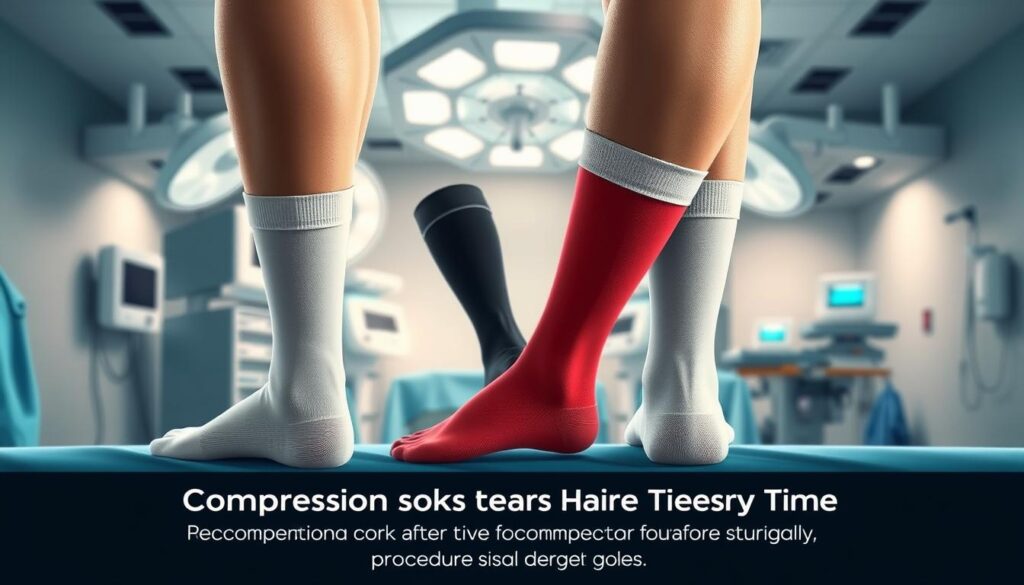
The time you need to wear compression socks changes based on your surgery. Knowing how long to wear them is key for a smooth recovery and avoiding problems.
Each surgery type needs a different approach to compression. We’ve outlined the suggested wear times for various surgeries to guide you through your healing:
- Orthopedic Surgeries (Hip or Knee Replacement):
- Typically 2-6 weeks of continuous wear
- Full-time compression during initial recovery
- Vascular Procedures:
- Often require 1-2 weeks of consistent compression
- May need longer wear time for complex interventions
- Gynecological or Abdominal Surgeries:
- Recommended 1-3 weeks of compression
- Depends on individual healing progress
Your doctor will give you the best advice for your specific situation. Your overall health, age, and how quickly you heal all affect how long you’ll need to wear compression socks.
Always talk to your healthcare provider to make a plan that fits your needs. This will help you recover better and faster.
Signs That Indicate When to Stop Wearing Compression Socks
Figuring out when to stop wearing compression socks can be hard. Everyone’s recovery is different. It’s important to listen to your body’s signs for the best healing after surgery.
The time you should wear compression socks varies. It depends on how well you’re recovering. You need to watch for certain signs and reach certain milestones in your recovery.
Physical Indicators of Recovery
- Reduced Swelling: A big drop in swelling in your legs or the area where you had surgery
- Little to no pain when you walk or move
- Improved skin color and warmth around the surgery site
- Normal blood flow with no signs of blood clots
Recovery Milestones to Consider
- Being able to move around easily without help
- Getting the okay from your doctor
- No risk of blood clots
- Doing well with your first rehab exercises
Don’t rush to stop wearing compression socks. Your doctor knows best when it’s time to stop. They will tell you when it’s okay to stop using them.
Listen to your body closely. Some people might need to wear compression socks for a long time. Others might only need them for a short while. The most important thing is to follow your doctor’s advice and watch how your body is healing.
Common Mistakes in Post-Surgery Compression Sock Usage
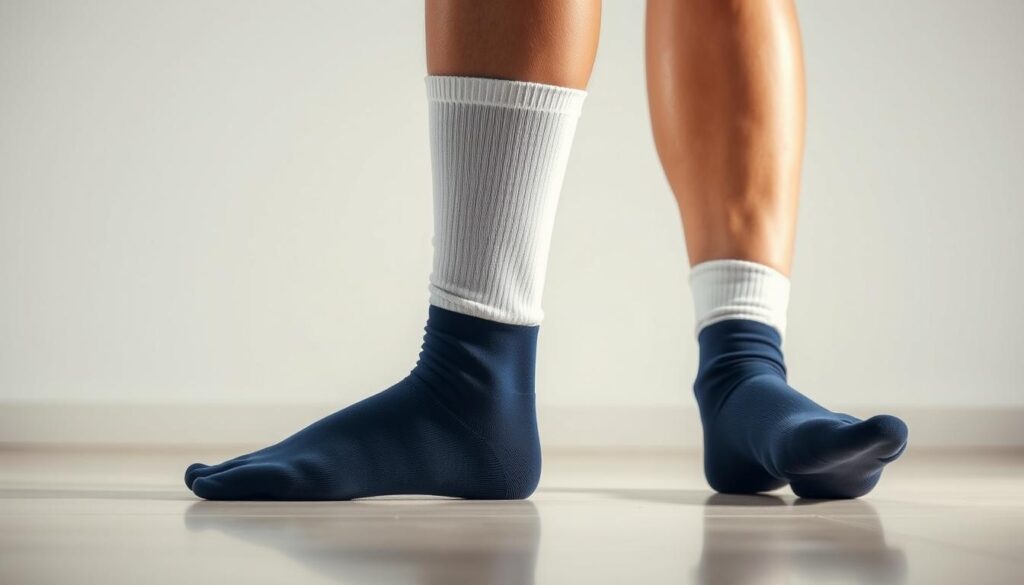
Wearing compression socks after surgery needs careful attention. Many patients make mistakes that can harm their recovery. It’s important to know how long to wear them for the best healing.
Let’s look at the most common mistakes patients make with compression socks after surgery:
- Incorrect sizing: Choosing socks that don’t fit right can lessen their benefits. They won’t help prevent blood clots or support blood flow as well.
- Wearing socks for an inconsistent optimal time frame for compression sock wear
- Neglecting skin care underneath the compression garments
- Ignoring signs of discomfort or possible complications
Sizing is very important. Compression socks come in different sizes. Wearing the wrong size can cause big problems:
- Less blood flow
- Skin irritation
- Potential pressure sores
- Less effective compression therapy
Another mistake is not following the right time to wear compression socks. Some patients take them off too soon or leave them on too long. This can slow down healing and raise the risk of complications.
Don’t forget about skin care. Not keeping the skin clean and dry under the socks can cause:
- Moisture-related skin infections
- Fungal growth
- Skin breakdown
We suggest talking to your healthcare provider. They can help you create a plan for wearing compression socks that fits your recovery needs.
Adjusting Compression Sock Wear Time for Different Activities
Recovery is not the same for everyone. When wearing compression socks after surgery, you need a plan that fits your life and healing. Knowing how to change your compression sock use for different activities can help a lot.
Your plan for compression socks should change as you heal. Different activities need different approaches to help you heal well and stay comfortable.
Nighttime Compression Sock Strategies
Compression socks help you recover even when you sleep. Here are some tips:
- Keep socks on while sleeping unless your doctor advises you to remove them
- Make sure socks aren’t too tight to block blood flow
- Check for any skin irritation or discomfort before bed
Physical Activity and Compression Sock Management
When you start moving again, follow these steps:
- Begin with gentle, low-impact exercises
- Slowly increase the intensity of your activities
- Talk to your doctor about the right exercises for you
- Watch how your body reacts to more movement
Pro tip: Always listen to your body and adjust compression sock wear based on individual healing progress and medical advice.
Medical Conditions That Affect Compression Sock Duration
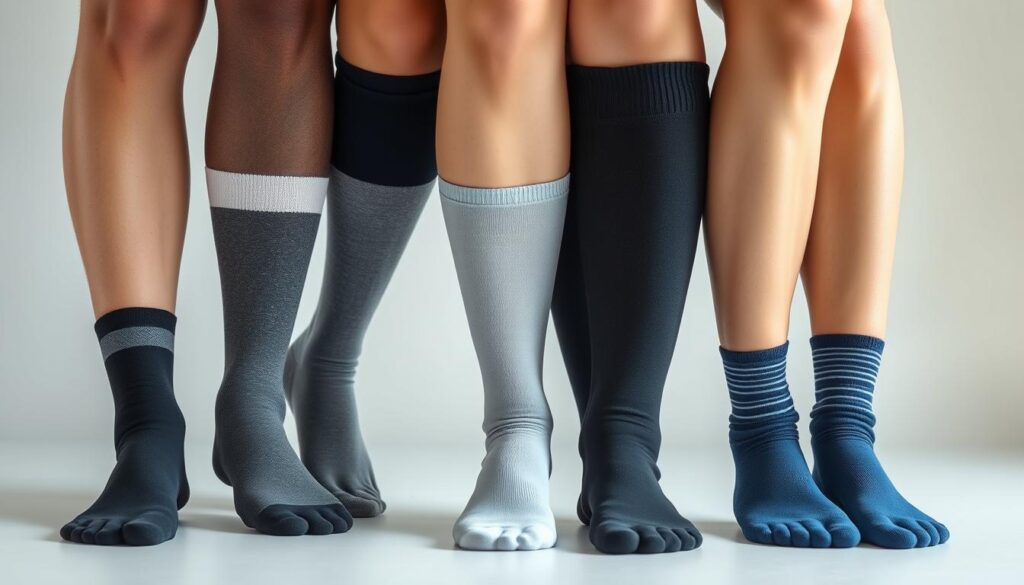
Some medical conditions can change how long you need to wear compression socks after surgery. It’s important to know how your health affects compression therapy. This knowledge helps ensure a safe and effective recovery.
People with chronic health issues might need to wear compression socks longer after surgery. Certain medical conditions can affect how long you should wear compression socks. These include:
- Chronic Venous Insufficiency (CVI): You might need to wear compression socks longer to handle circulation problems
- Lymphedema: Wearing them for a longer time helps with fluid retention and supports lymphatic drainage
- Diabetes: You might need to wear compression socks longer because of circulation risks
- Peripheral Artery Disease (PAD): You’ll need special care for how long and how to wear compression socks
If you have skin conditions or a weakened immune system, talk to your doctor about how long to wear compression socks. Each condition brings its own challenges that can change how you recover.
Here’s what we suggest:
- Talk to your doctor about your medical history
- Get advice on how long to wear compression socks
- Watch your recovery and circulation closely
- Be ready to change how long you wear compression socks based on your doctor’s advice
Remember, your health is unique, and so should be your recovery plan for compression socks. Getting advice from a healthcare professional ensures you wear them for the right amount of time. This supports your specific health needs.
Managing Comfort While Wearing Post-Surgery Compression Socks
Wearing post-surgery compression socks can be tough, but you don’t have to sacrifice comfort. Our tips will make it easier to follow the recommended wear time. You’ll feel more confident and comfortable.
Essential Skin Protection Techniques
Keeping your skin safe while wearing compression socks is key. Here are some important steps:
- Keep skin clean and dry before putting on socks
- Use gentle, fragrance-free moisturizers
- Check skin daily for any signs of irritation
- Rotate sock positions to prevent pressure points
Comfort-Boosting Strategies
To boost comfort, try these smart tips:
- Choose breathable, moisture-wicking fabrics
- Ensure proper sock sizing for optimal comfort
- Take short breaks when medically approved
- Use cooling gel or powder to reduce moisture
Pro tip: Always consult your healthcare provider about the recommended duration for compression sock usage specific to your recovery needs.
By following these tips, you can make wearing compression socks more comfortable. Your recovery can be both effective and comfortable!
When to Consult Your Doctor About Compression Sock Usage
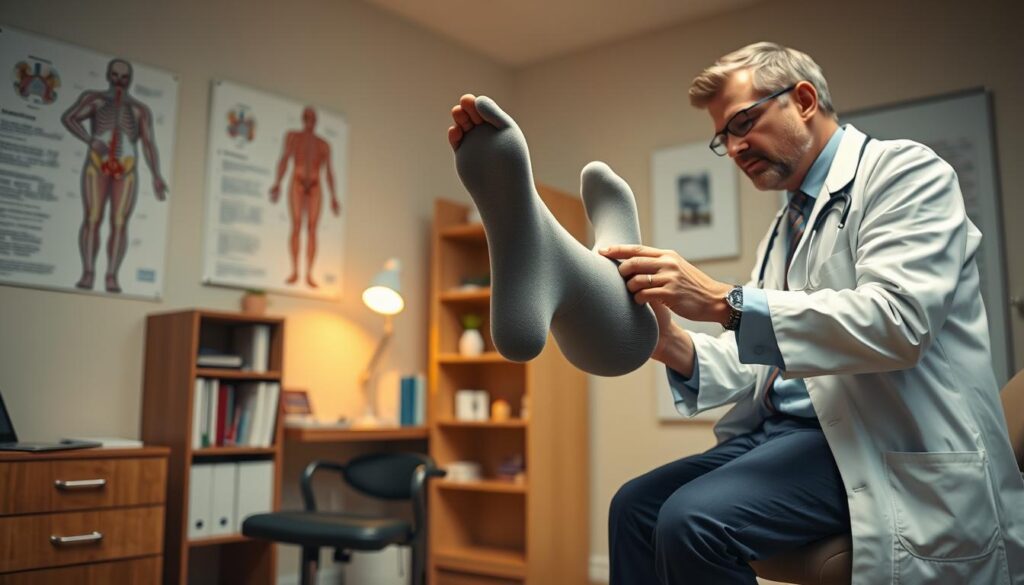
Understanding when to seek medical advice is key after surgery. This is true, even for something as simple as wearing compression socks. Your doctor is there to guide you through this part of your recovery.
Figuring out how long to wear compression socks after surgery can be tricky. There are a few times when you should talk to your doctor:
- Persistent pain or discomfort while wearing compression socks
- Unexplained skin changes or irritation around sock areas
- Swelling that doesn’t improve or worsens
- Signs of possible blood circulation problems
- Difficulty figuring out how long to wear compression socks
Some signs while wearing compression socks after surgery mean you need to see a doctor right away. Your recovery is unique, and personalized medical guidance ensures optimal healing.
| Symptom | Action Required |
|---|---|
| Severe leg pain | Immediate doctor consultation |
| Unusual skin discoloration | Schedule medical evaluation |
| Increased leg temperature | Prompt medical assessment |
Getting professional advice is essential when you’re unsure about using compression socks. Doctors can give you tailored advice based on your surgery, health, and how you’re recovering.
Remember, talking openly with your healthcare provider is important. It helps ensure you’re using compression socks safely and effectively during your recovery.
Transitioning Away from Compression Socks
Leaving behind your compression socks is a big step in your recovery. The right time to stop wearing them depends on how well you’re healing and your surgery. It’s important to know how to stop using them safely to keep recovering well.
Transitioning needs careful watching of your body and slowly reducing how long you wear compression socks. Our experts will guide you through this step with confidence.
- Consult your healthcare provider before making any changes
- Observe your body’s response during the transition
- Gradually reduce wearing time
- Monitor for any swelling or discomfort
Listen to your body’s unique recovery rhythm. Some people might need compression socks for longer, while others can stop sooner. How fast you heal decides how long you need compression socks.
| Recovery Stage | Recommended Approach |
|---|---|
| Initial Transition | Reduce wear time by 2-3 hours daily |
| Mid-Transition | Alternate between compression and regular socks |
| Final Stage | Minimal compression or complete discontinuation |
Watch out for warning signs during your transition. If you have ongoing swelling, pain, or color changes, see a doctor right away. Your doctor can give you advice that fits your specific recovery needs.
Celebrate this big step in your healing! Moving away from compression socks shows you’re making great progress in your recovery.
Alternative Compression Methods During Recovery
Recovery isn’t the same for everyone. While compression socks are great, they’re not the only thing you can use. We’re looking at new ways to help your body heal, like other compression methods.
Understanding how long to wear compression socks is key. There are many devices and recovery methods that can help your body heal.
Cutting-Edge Compression Devices
- Pneumatic Compression Pumps: These machines mimic muscle contractions
- Compression Sleeves: They’re like socks but more flexible
- Compression Wraps: These wraps offer adjustable support for certain areas
Complementary Recovery Techniques
Using compression with other recovery methods can make healing better. Here are some techniques to try:
- Gently lifting the affected limbs
- Doing specific physical therapy exercises
- Using massage to help blood flow
| Compression Method | Recovery Benefits | Recommended Duration |
|---|---|---|
| Pneumatic Compression Pump | Boosts blood flow | 30-60 minutes daily |
| Compression Sleeves | Supports muscles | 4-8 hours per day |
| Compression Wraps | Protects joints | As needed during recovery |
Your recovery plan should be just for you. Talk to doctors to find the best compression methods for your needs.
Conclusion
Understanding postoperative compression sock wear time can be tough. But our guide has given you the key info you need. We’ve covered the basics of when and how to use these recovery aids.
Your recovery path is unique, and compression socks are key to healing. Listen to your body and follow medical advice to get the most out of them. Being informed and proactive is the way to go.
Doctors stress the importance of personalized care in recovery. While there are general guidelines, your specific situation will guide the best use of compression socks. Always talk to your doctor to find what works best for you.
Compression socks are not just for medical use; they’re a healing ally. Treat them as part of your recovery gear. Using them correctly can greatly improve your healing journey.



